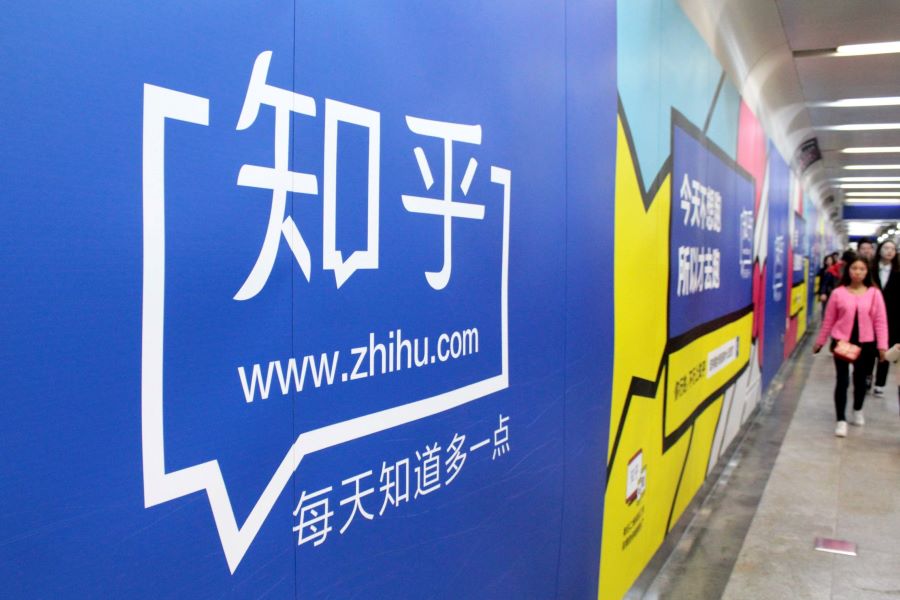In Search of Profits, Q&A Site Zhihu Finds New Answer in Vocational Education

Company often called the ‘Quora of China’ reported a huge jump in vocational training revenue in the first quarter, even as its overall losses widened
Key Takeaways:
- Zhihu’s revenue grew 55.4% in the first quarter, but its adjusted net loss grew by an even bigger 89.8%
- Company’s vocational education services could be a major new growth engine, as China encourages private sector investment in the area
By Christina Meng
In the ongoing game of “yes” and “no” being played by leading Q&A site Zhihu Inc. (ZH.US; 2390.HK), the answer on whether the company could turn its first-ever profit in its latest earnings report was a clear “no.” But Zhihu, often called the Quora of China, is trying hard. Its latest results show it may have finally found an answer to the profit challenge in vocational training services, which experienced explosive growth during the first quarter.
Zhihu’s latest earnings report released last Wednesday, its first since it made a dual listing in Hong Kong, showed its revenue grew 55.4% year-on-year to 743 million yuan ($111 million) in the first quarter of 2022. But its adjusted net loss grew by an even bigger 89.8% to 367 million yuan from 194 million yuan a year earlier.
Despite widening losses, Zhihu still achieved revenue that beat its own previous forecast against the backdrop of repeated Covid outbreaks that led to massive closures and other macroeconomic headwinds. That seems to show that founder and CEO Zhou Yuan is making good on his quest to “turn good content into good income” by diversifying the company’s revenue sources.
Investors seemed encouraged by the report, bidding up Zhihu’s U.S. stock as much as 10% the day the results came out, though the shares later gave back much of those gains to close up 2.26%. But more people took notice the next day, sparking a 22% rally in the shares, giving Zhihu a price-to-book (P/B) ratio of just over 1. Still, at its latest close of $1.55 the stock is well below the $9.50 price for its IPO shares in March last year.
The latest financial statement shows that Zhihu is making steady progress in optimizing its revenue structure, which mainly relies on online advertising, commercial content solutions and paid memberships. As it experiences rapid user growth, commercial content solutions has become the company’s largest revenue source, accounting for 30.5% of its total, with revenue up 87.7% year-on-year to 227 million yuan in the first quarter.
Another noteworthy highlight was the emergence of Zhihu’s vocational education services as a new growth engine, with explosive year-on-year growth of 1,196%, accounting for just over 5% of total revenue. This was driven mainly by more diversified vocational training courses and related M&A in the second half of 2021, the company said, seizing on China’s encouragement for the private sector to play a greater role in such adult-oriented vocational training.
It’s also worth noting that Zhihu’s average monthly active users (MAUs) rose 19.4% in the first quarter to 102 million year-on-year, and its average monthly paid members surged 72.8% to 6.9 million over the same period, both exceeding market expectations.
Analysts were happy with the results, pointing out the company’s latest performance shows it can perform well even in the face of the many challenges now facing Chinese companies and should be given a higher valuation premium.
The company’s ability to grow in the face of such headwinds contrasts with older content communities such as Hupu and Douban, which have grown much slower and failed to make their own listings. One reason for Zhihu’s lower valuation may lie in its lower use of photos and video that are most popular on the internet and sexier to investors. That’s made it difficult for Zhihu to compete with the likes of video specialists like Bilibili (BILI.US; 9626.HK) and Kuaishou (1024.HK), which have far higher P/B ratios of 2.54 and 5.78, respectively.
Stock boosters
In the face of its weak valuation, Zhihu certainly can’t be faulted for lack of effort to improve its efficiency and prop up its shares.
The company announced a $100 million share buyback with its latest results. And while it didn’t provide any second-quarter forecasts in its latest report, most likely due to all the economic uncertainties, Zhou said on Zhihu’s earnings call that advertising and business content solutions were still expected to achieve double-digit growth in the second quarter. He added that reducing costs and increasing efficiency will be a key task this year and next.
Zhihu has continuously lost money since its founding in 2010. Such red ink didn’t previously bother investors, who valued companies like Zhihu for their potential rather than profits. But as headwinds increase, including inflation and a slowing Chinese economy, profitability has become more important. That’s leading Zhihu and its peers to try to reduce costs and increase efficiency as a way to win back investor favor.
Companies are increasingly turning to job cuts as part of that strategy, and Zhihu has been no exception. Rumors of job cuts at the company first began at the start of this year, and Zhihu reportedly made a fourth round of redundancies across its technology, commercialization, education and community sections just before release of its latest results. Reports said the cuts have affected 20% to 30% of the company’s workforce.
Zhihu didn’t confirm any numbers, but called such cuts a normal part of its business and organizational optimization. On the earnings call, Zhou said Zhihu’s headcount will be structurally changed and downsized, and appeared confident about the company’s ability to move out of the red. Zhihu is just the latest internet company to turn to such layoffs to control costs, following similar moves by big names like Alibaba (BABA.US; 9988.HK), Tencent (0700.HK) and Huya (HUYA.US).
Internet analyst Zhang Shule noted it’s impossible to reduce red ink through job reductions alone, and that improving revenue is more important.
Since it began its commercialization drive in earnest in 2016, Zhihu has dabbled in live broadcasting, short video, e-commerce and other fields, in addition to its core advertising and paid memberships. But for various reasons such as timing and strategy, most of its attempts have failed to take off. In that regard, it does appear that Zhihu may have finally found a new winner with vocational education business, which could help its commercialization drive.
China has aggressively encouraged private sector development of vocational education, in sharp contrast to its recent crackdown on providers of education services for K-12 students. The State Council first issued a National Vocational Education Reform Implementation Plan in January 2019. Since then, other government agencies have issued a steady stream of supporting policy documents emphasizing the importance of modern vocational education and lifelong learning. The state has also provided financial support for such efforts.
Seizing on that support, Zhou has proposed making vocational education services as one of Zhihu’s long-term strategies. From last year, the company launched its “Product Trainees” and “Zhixue Tang” vocational education apps, and also invested in two adult education platforms, Shanghai Pinzhi Education and Papa Education.
But Zhihu is hardly alone in pursing the sector, and could face strong competition. Some companies like New Oriental Education (EDU.US;09901.HK), which lost a huge piece of their business during last year’s K-12 crackdown, are now also piling into the space. And there’s also competition from others such as Beijing Offcn Education Technology (002607.SZ) and Huatu Hongyang Corp.
To subscribe to Bamboo Works weekly free newsletter, click here





